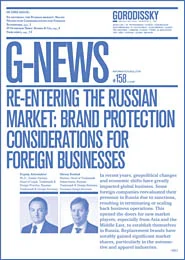Successful representation of the client in a series of lawsuits over illegal use of the invention
Description
Under an exclusive license agreement, the Client (Claimant) uses an invention that is a technical solution (device) used in the oil industry for continuous completion of oil-bearing strata. This technical solution is applied by the leading oil producing companies of the Russian Federation.
The Defendant unlawfully used the invention through manufacturing and commercialization of disputed products as well as through the use of the invention in his business activities.
Solution
Lawyers of Ekaterinburg office of the firm (Ekaterina Solonitsyna, Nikolai Roshchupkin) have proposed a two-stage strategy for protection of the Client’s interests consisting in bringing at first a non-property claim in order to prove the actual infringement of the exclusive right to the invention and to prohibit the Defendant from using it, and, after that, based on the court decision obtained, bringing a claim for recovery of compensation and for withdrawal and destruction of the disputed products.
The Defendant was located in another region and the location of his manufacturing facilities was unknown. Collection of evidence was complicated by the fact that the manufacturers of the relevant items were aware of the parties involved in the market and each other’s core activities. For this reason, a third party was involved in evidence gathering.
Thus, one of the key evidence has been the “evidential purchase” of the disputed item, which was recorded by a notary. In addition, a number of measures were taken, including out of court patent and engineering study of the disputed item obtained as a result of the “evidential purchase”, and the information posted on the Defendant’s website on the offer of disputed products for sale was recorded by various means (notarial protocols, Internet archive).
Result
In 2018, based on the evidence gathered, a claim was brought to prohibit any use of the invention.
During consideration of the case, a forensic patent and engineering expert examination was commissioned (a comprehensive expert examination prepared by specialists of various disciplines: patent attorney and technical specialist being a PhD in engineering).
The disputed item obtained as a result of the “evidential purchase” had been stored by a third party on the premises of one of Ekaterinburg plants, which required an on-site inspection of the product, previously authorized by the court of first instance. The product was inspected on the premises of the plant involving the parties and accompanied by the analysis of the disputed item due to its design complexity.
The opinion of the forensic expert examination confirmed the use of the invention in the disputed item and, at the same time, the conclusions of the pre-court patent study, based on which a non-property claim had been brought.
Taking into account that the actual commercialization of the disputed item was recorded by a notary and the use of the invention in it was confirmed by both the pre-court opinion and the forensic expert examination, the court of first instance satisfied the stated claims in full and superior courts upheld them.
In 2020, after the court decision upon the non-property claim became effective, a second claim was filed: a claim for recovery of compensation in the amount of 29,700,000 Russian rubles and for withdrawal from the market and destruction of the disputed products. The compensation was calculated as double value of the right to use the invention (Clause 2 of Article 1406.1 of the Russian Civil Code).
The Client and the right holder concluded an exclusive license agreement, therefore, in order to mitigate the risks of a significant reduction in the compensation, an opinion on the value of the right to use under the conditions of a non-exclusive license was prepared in advance. In addition, evidence showing that the Defendant’s infringement is continuing and continues during the legal proceeding as well was gathered.
The court of appeal awarded compensation from the Defendant in the amount of twenty-two million four hundred and forty thousand (22,440,000) Russian rubles.
Within the existing court practice, this amount of compensation is significant. Moreover, there are very few court cases where the compensation is calculated as double value of the right to use an invention, utility model, or industrial design. Thus, as per the data given in the Intellectual Property Rights Court Bulletin [1], the provision of Clause 2 of Article 1406.1 of the Russian Civil Code is referred to in only 46 judicial acts for five years such clause has been effective (from 01 January 2015, when the provision became effective, to March 2020).
In the case for recovery of compensation, the two-stage right protection strategy made it possible to proceed from a prejudicial act, which had already established the actual infringement and evaluated much of the evidence that had become key for determining the amount of compensation, thus reducing the period required to consider the case. So, it took 14 months to consider the non-property claim in the court of first instance and 6 months to consider the claim for recovery of compensation.
As a result of the judicial acts, the Client’s (Claimant’s) legal and financial interest has been satisfied.
[1] Radetskaya, M. V., Turkina A. E. (2020, March). Overview of Court Practice on Recovery of Compensation for Infringement of the Exclusive Right to Intellectual Property or Means of Individualization. Intellectual Property Rights Court Bulletin, 27. Par. 4, p. 34.









